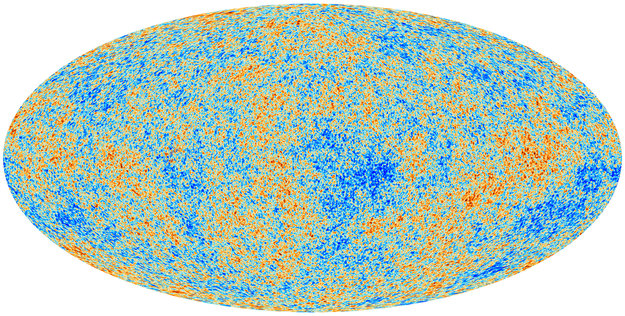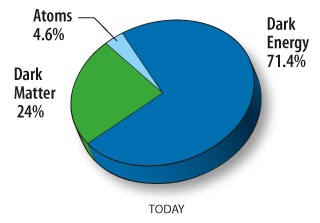
The Expanding Universe in a Steady State (animation)

The Big Bang (animation)
Our universe is expanding! That is, groups of galaxies are moving away from each other according to Hubble's Law. This law states that the farther a galaxy is from us, the faster it is moving away from us. Any model used to explain the birth of the universe must take this into account.
Prior to the 1960's, there were two competing ideas about the origin of the universe. One was called the Steady State Theory, and the other was called the Big Bang Theory. The Steady State Theory claimed that the universe had no beginning, ... will not have an end, ... is infinite, ... will expand forever, ... and looks the same for all time. To keep the universe looking the same, ... new matter had to be created in the void left by expansion. In this respect, the universe is continually being created.
|
The Expanding Universe in a Steady State (animation) |
The Big Bang (animation) |
The Big Bang Model claimed that the universe was created all at once. Just trace expansion backwards in time and everything was together at the beginning. In this model, the universe is still expanding as a result of this "explosion". Which model is correct?
In the 1960's, a prediction was made that if the universe was created in a Big Bang, there should be residual radiation from it, and it should permeate all of space. In 1964, Arno Penzias and Bob Wilson, working for the Bell Laboratories, discovered this "cosmic background radiation". It confirmed the Big Bang Model. Now all we have to do is work out the details. That is, according to all our best models, the universe did have a definite beginning.
This conclusion has been confirmed by observation. If the universe had no beginning and behaved like the Steady State model discussed above, it would look essentially the same in all places and at all times. This is not backed by observation. We see a very different universe when we look very far away (which is also a very old universe) compared to what we see around us (which is a more recent universe). That is, the universe is definitely changing with time.
The cosmic expansion discovered by Hubble is a result of the Big Bang. The Big Bang is not like any "explosion" you've ever witnessed. It is literally an explosion of reality, ... the creation of matter, energy, space and time. It is pointless to ask what happened before the Big Bang, ... there was nothing. Or to ask what caused it! It is an excellent boundary between science and religion simply because no scientist can investigate it, explain it, or predict its occurrence. Well, ... not exactly. String theorists are trying to find ways to use their models to explain how a universe can occur, ... but that discussion is beyond the scope of this project.
In a way, the universe is still being "created" as you read this. This is because the cosmic expansion we observe today is a result of new "space" which is created each and every day. This topic forces you to think in ways you are not usually accustom to, .... let me explain. Imagine you place two people on opposite goal lines of a standard football field. If each person now runs toward the goal posts behind them, you would record a Doppler red shift as they move farther apart from each other. Now suppose they don't move at all from the goal line. Rather, an earthquake creates a crevasse at the 50 yard line which is 10 yards wide. During that process, the two people would still be receding from each other, because new space was created between them. Each day, new space is being created (as a result of the Big Bang) in every section of the universe. As a result, galaxies which are far away from us today, are even farther away from us tomorrow. This is how astronomers explain the cosmic expansion. It is also how they are able to explain the cosmic background radiation.
Imagine a very young universe which was very hot and dense (slightly after the Big Bang). At this time, space would have been filled with high energy gamma radiation (with a very short wavelength). Can we see this radiation? Sure! All we need to do is look very far away, because we are also, then, looking into the distant past. Any gamma ray photon which were created then would take many billions of years to reach us, and all that time, would be under the influence of an expanding universe. The cosmic expansion would essentially stretch the wavelength of the photon from a short wavelength gamma ray to a very long wavelength microwave. By the time it reaches us, we would see a flood of microwaves from that early universe. Now if that doesn't freak you out, ... it would be coming at us from all directions because any direction you point to, you are looking at an earlier universe.

Why we receive the cosmic background radiation (animation)
The space missions - COBE, WMAP, and Planck spent years mapping the cosmic background radiation. First maps showed the cosmos background radiation was incredibly smooth (same in all directions) and represented a blackbody radiator with a temperature of only 2.7 Kelvin. This implied that the very early universe was the same temperature in all directions. Astronomers saw no reason why this would have to occur and refer to phenomena as the horizon problem. Newer, more sensitive, instruments did eventually find slight variations in intensity. The results are displayed in the image seen below. The red areas are places where the background radiation is a bit hotter and the blue areas represent areas where the universe was a bit cooler.

Image of the cosmic background radiation (taken by the Planck probe)
It was important to discover these very slight variations in background intensity. We know we live in a very lumpy universe (galactic clusters and superclusters). How can that come from an earlier "smooth" universe? Stated in other terms, the red patches in the image were places where matter accumulated. Huge clusters of galaxies would eventually form from these hot area (where matter and energy was concentrated) and huge cosmic voids would result from the cooler regions. These variations (between the hot regions and cool regions) represent differences of 1 part in a million, so you should understand that the background is still very uniform overall, ... but it does vary slightly, ... enough to make the lumpy universe we see today.
The Hubble constant (introduced earlier) makes the assumption that the rate of cosmic expansion is the same for all time. However, the rate of cosmic expansion may vary greatly as time progresses. The standard Big Bang model has always assumed that gravity is constantly working on the universe in such a way that the rate of expansion will slow as time progresses. That is, as time progresses, the rate of expansion decreases. Why wouldn't it? Gravity is constantly trying to pull things back together.
The universe is expanding, ... but is it enough to overcome gravity? The standard Big Bang model says the expansion should always decrease with time (just like a ball tossed upward), but with enough gravity, it may slow down to a halt, ... and then start collapsing .... OR ... the initial expansion may be enough to achieve "escape velocity" and the universe keeps expanding forever. A universe which keeps expanding is known as an open universe. A universe which will eventually come back to a "Big Crunch" is known as a closed universe. Which universe do we live in? According to the standard model, it all depends on the strength of the initial expansion (the toss) and the force of gravity (which would pull the universe back). This last variable depends on the total mass of the universe, including all dark matter, and even all forms of energy (since Einstein showed that matter and energy are interchangeable).
Astronomers realize this offers an infinite number of possibilities. That is, any total mass below a critical value (known as the critical density) will make the universe open. Any total mass over the critical density will produce a closed universe. Lying just between these two possibilities is a universe which is exactly at the critical density. In this case, the universe would have the minimum total mass to make the universe open. This possibility is known as a flat universe. Based on the best observational evidence at the time, the universe appeared to be flat. This observation disturbs astronomers because it is like flipping a coin, and it ends up on its edge. There is no reason why the universe should be this close to the critical density. This situation is known to astronomers as the flatness problem.
The current date suggests that the universe was created somewhere around ~14 billion years ago (best current estimate is 13.8 billion years).
Astronomers don't like to rely on coincidence when creating their models. The horizon and flatness problems described above showed that the universe appeared to "just happen" to be uniform in temperature, and "just happen" to be at a critical density (according to the standard Big Bang model). This forced changes by the modelers. Using the current laws of physics, a solution was found. If the universe went through an initial stage of "super expansion" (known as inflation) near the very beginning, it would produce (as a matter of consequence) a universe which would appear flat and uniform in temperature. In other words, by "tweaking" the standard model, these annoying problems go away. The best part is that it can all be explained logically from the laws of physics (the details are beyond the scope of this project).

Standard Big Bang Model (animation) |

Inflationary Universe (animation) |
In a time very, very close to the Big Bang, space acquired an enormous repulsive pressure from "negative gravity" as the fabric of space and time were undergoing a metamorphosis. This all occurred between 10-35 and 10-32 seconds after the Big Bang. (This inflation started .00000000000000000000000000000000001 seconds into our universe). During this extremely short time, the universe grew from the size of a proton to the size of a walnut ... or stated another way, the universe grew by a factor of 10^78 times in that very short time. It then slowed down to a much slow rate of expansion. I leave it to you to research this topic further if you wish to understand all the details (which are quite complex). However, I would like to offer two unscientific analogies which might help you see why inflation solves these two problems (skim over lightly if you wish):
- Horizon Problem - The image above shows what happens if you take a spectrum and stretch it out. Then take a small section of that spectrum, and stretch it out. Finally, you take a section of that spectrum and stretch it out. You end up with a strip that looks the same color. If the universe was stretched out like this, any small temperature differences would be spread out (after inflation) to look almost smooth.
- Flatness Problem - If you apply the theory of relativity to the topic of cosmic expansion, any closed universe will have sufficient mass to cause a light beam to curve and eventually return to its point of origin. It is like drawing a line on a ball. Even though the line is straight, it eventually comes back to the starting point. If the universe has less mass, the curvature decreases. It is like tracing the line on a bigger ball, but you still eventually get back to the starting point. As you consider densities closer and closer to the critical density, it is like tracing the line on a bigger and bigger ball. Eventually, the ball starts looking flat as you get closer to the critical density. Inflation is like making the ball very big. From your view (of this ball), it would appear virtually flat. That is, it would automatically appear to look like a universe which is very close to the critical density.
Even if that doesn't make any sense to you, that is OK. Astronomers now accept the idea that for a very brief period just after the Big Bang, the universe underwent a super rate of expansion known as inflation. After that, the universe kept expanding but at a much slower rate.
: In March 2014 astronomers announced the first observational evidence that supports inflation. A new map of the cosmic background radiation shows ripples in space-time (gravity waves) that can only be accounted for if the universe underwent inflation.
When our universe got started, it was very, very, very hot and dense. However, there was no mass in this early universe - it was all energy. This was known as the Radiation Era. After the initial period of inflation, the expanding universe cooled to the point that particles could come into existence (from the energy). The first building blocks of matter, quarks, formed between 10-35 to 10-4 seconds after the Big Bang. Quickly afterwards, more massive particles were able to form. For example, when the universe was only .0001 seconds old protons and neutrons were able to form. Soon afterwards, electrons were able to form. During the first minutes of the universe, nuclear fusion reactions were able to take place, producing large quantities of helium. The cooling universe was unable to manufacture much of the other elements beyond helium because they require higher temperatures to fuse, but the universe was cooling instead. As a result, the only kinds of ordinary matter produced were hydrogen, helium, and a little lithium. Most of the heavier elements on the periodic table were produced much later in the interiors of massive stars. As the universe continued to cool, it eventually reached the Matter Era. About 380,000 years after the Big Bang, ordinary atoms were able to form. That is, electrons started orbiting the nucleus of protons and helium nuclei. This marked a turning point in the universe because this was the time the universe became transparent. When we observe the cosmic background radiation, we are actually observing radiation from that era. From there, matter started lumping together to form stars and galaxies. During this early period, matter was closer together and black holes were consuming huge quantities of matter (becoming super luminous, and super massive in the process, .... which we now see as quasars). Eventually galaxies formed their present appearance, but they still interact by tidal forces, collisions, and galactic cannibalism.
What was before the Big Bang? Don't ask! There was nothing - NOTHING! There was no space, mass, energy, or even time. Since time starts at the Big Bang, there can be nothing before that.
Where was the Big Bang? This is the same as asking where the center of the universe is. Since everything is in the universe, any point can be considered the center. If we suppose the universe is 14 billion years old, then any observer, ... in any place, can claim to be at the center. Remember the Hubble Law? All distant galaxies seem to be expanding from you (as if you were the center). This is true no matter where you are. Want to point to the Big Bang? Point anywhere. Just go far enough in that direction and there it is (but you'll never see it ... read on).
How big is the universe? If the universe is 14 billion years old, you might think that the universe has a radius of 14 billion light-years. That would be true in a universe which is not expanding. The actual size of the "observable" universe is considerably larger than 14 billion light-years in radius because of cosmic expansion. This is because a photon coming from a very distant galaxy has also been traveling through space for a very long time. During this time, space itself has been expanding. What was once an inch has expanded to a foot ... then a yard (for example). An expanding universe 14 billion years old can produce an "observable" universe perhaps 50 billion light-years in radius by now. The actual size depends on the rate of cosmic expansion and how that rate changes with time. Is there an "edge" to the universe? There is an "observable edge" to the universe but there are certainly things beyond that which we can not "see". Imagine a galaxy so far away that cosmic expansion causes it to move away from us faster than light (yes, ... this can happen because cosmic expansion is not bound by relativity). That would place this galaxy outside our "horizon" because a beam of light coming from that galaxy would never reach us. You can lose a lot of sleep thinking about this one. If the rate of cosmic expansion is accelerating with time (see below), it may be that our observable universe will get progressively smaller and smaller as time progresses.
Is everything expanding? No! Your car will be the same size tomorrow as it is today. It is space that is expanding. This expansion is meaningless on small scales, ... so you don't have to worry about Earth (or even the Milky Way) getting bigger. Cosmic expansion can not even overcome the random motion of galaxies within a gravitationally bound group (like our local group of galaxies). It is only on very large scales that we have to take cosmic expansion into consideration. A galaxy 5 billion light-years away today will be even farther away from us next year because of cosmic expansion.
As stated before, the universe appears to be flat. That makes it open, and it will continue to expand forever. However, being so close to the critical value also means that any margin of error could produce a closed universe as well. In the late 1990's, it was like some presidential elections, .. too close to call. It was assumed that it all depends on the amount of gravity there was in the universe (i.e., total mass).
Observations of distant Type Ia supernovae (1998) showed a very bizarre result. Two independent studies showed that the universe is not slowing down as it ages, but rather, ... speeding up! This surprising results stunned astronomers because they have no way to explain it. They invented a term called dark energy to account for this phenomena. Dark energy is a new force which acts like "anti-gravity". That is, it produces a cosmological repulsion to account for the acceleration. No one has a clue about the actual nature of this force, but it definitely makes the universe expand forever (and, therefore, exist forever). Astronomers have even claimed that dark energy is a force that progressively gets stronger as the universe ages. If so, the universe will suffer a strange ending. Considering that the force of gravity gets progressively weaker as the universe expands, dark energy will slowly become the dominant force. If carried to its extreme, the cosmic expansion will eventually become a factor when considering smaller and smaller volumes of space. Imagine a day when dark energy becomes so effective that we are unable to see any other galaxies except the ones in our local group of galaxies. Eventually the repulsive nature of this force will grow strong enough to rip apart the local group of galaxies, ... then our own Milky Way, ... then our solar system, then the planets themselves. In the very distant future, it will work on smaller scales, eventually tearing apart atoms. Imagine a universe expanded to the point where the closest electron is 14 billion light-years away! Astronomers call this a Big Rip. Talk about cold and empty.

Does the universe do this? Notice the acceleration toward
the end. (animation)
Dark energy really changed how we look at the universe. There is so much of it (whatever it is) that it actually dominates us. Allow me to explain. You learned earlier that matter and energy are interchangeable from E = M c^2. . From that perspective, we can compare ordinary matter, dark matter, and dark energy on a level field. The numbers may vary a few percent over the years but the pie chart below says it all. In the whole universe, we can only observe a few percent of it (atoms). Now that is a mystery!
In June 2020 a tiny bit of the mystery was solved. The chart below shows that about 5% of the universe is made up of "atoms" ... or stuff we understand. Technically ordinary matter (protons & neutrons) are called baryons but even though theory predicted the universe constituted 5% of this stuff, we could only account for about half of it. This was known as the "missing baryon problem". That problem was solved when it was found in the space between galaxies. Read about it here. There is still A LOT in that chart below we still know very little about.

Credit NASA
Want more punishment? The folks working on string theory have proposed that our universe may not be the only one. What? The concept of a multiverse suggests that our observable universe may be just one in an infinite (or finite) number of unseen and undetectable universes. Each universe can have a different set of physical laws (for example, gravity could behave differently). So each universe would behave differently. I don't claim to understand the details but any un-testable claim boarders on pseudoscience ... besides, I'm doing fine with just one universe.
So here we are. The last unit of this class, and what do we know?
To think that only about a century ago, we were pretty clueless about the structure and evolution of the universe ... I'd say we have come a long way in a very short time. To say we are in a golden age of astronomy is an understatement. But here we are ... a tiny speck going around a single star located in the Orion spur of the Milky Way galaxy ... only one galaxy in our "local group" of a few dozen galaxies ... at the edge of the Virgo super cluster! Wondering ....
Are we alone? (I hope not .... see the research topic answers on life in the universe.)
What is dark matter? (We only know it exists and where it is.)
What is this strange repulsive force which could dictate the ultimate fate of the universe (dark energy)?
The thing that interests me the most is .... what is it about the universe we have yet to discover? There will be unexpected surprises yet to come!
In short, when you consider the "big picture", we still have a LONG way to go. However, I believe that is why astronomy is so interesting.
I will leave you with something to think about. In the great debate of the 20’s – Island Universe (Curtis) vs. Big Galaxy (Shapley) it would appear Curtis (and Hubble) won the battle but, in fact, Shapley will win the war. You see, two things are going to happen:
All the galaxies within our local group of galaxies (which are gravitationally bound) are destined to merge (M31 is already on a head-on collision course the Milky Way). The result will be one HUGE elliptical galaxy.
The expansion of the universe is an expansion of the fabric of space itself. The galaxies are just going along for the ride. There is no speed limit to that expansion (space-time is not bound by Einstein’s limitations) so there exists a visible horizon to our own view of the universe. That is, there are parts of universe where the expansion exceeds the speed of light, and we will never get to see things beyond that point. Even without taking dark energy into account, over time the expansion of space-time shrinks our view of the universe. This will eventually lead to a point where all the galaxies outside our local group are no longer visible to us (way, way into the future).
When both of those things happen, Shapley’s “big galaxy” is all we have left to look at.
I hope you enjoyed this class.
Jim
©Jim Mihal 2004, 2014, 2019, 2023 - all rights reserved